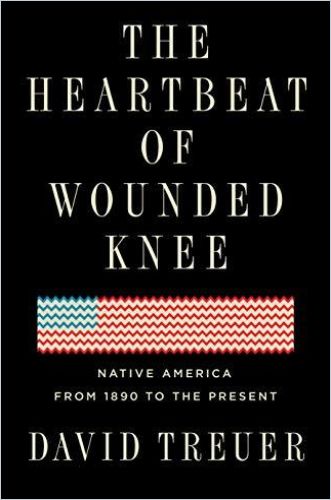Ojibwe tribe member Dr. David Treuer delivers Native American history illustrated through the lives of everyday individuals.

Native American Resilience
Dr. David Treuer presents a heartfelt account of North American Indians from their origins more than 12,000 years ago to today. To present Native Americans’ struggles and resilience, Treuer focuses on the aftermath of the Wounded Knee massacre in 1890.
Treuer, a member of the Ojibwe tribe of the Leech Lake Reservation in northern Minnesota, teaches writing and literature at the University of Southern California. A New York Times bestseller, The Heartbeat of Wounded Knee was a finalist for the National Book Award. It was longlisted for the Andrew Carnegie Medal for Excellence and named a Best Book of the Year by The New York Times, TIME, The Washington Post, the New York Public Library, National Public Radio and Library Journal. NPR’s evaluation said, “Chapter after chapter, it’s like one shattered myth after another.” The New York Times Book Review called it, “An informed, moving and kaleidoscopic portrait.”
Wounded Knee
Treuer explains that the Wounded Knee massacre followed four centuries of violence, shameful treaties, rampant infectious diseases and manufactured famines that reduced the Native American population in North America from perhaps five million to fewer than 250,000.
Wounded Knee stands for an end and a beginning.David Treuer
Treuer asserts strongly that in the 130 years since Wounded Knee, Native Americans have overcome continuous dishonest, violent and greedy actions by the US government. The author proudly states that Native Americans have resisted cultural genocide with resilience, flexibility and creativity.
Treuer cites Christopher Columbus as only the first of the Spanish, Italian, English, Dutch and French explorers who encountered Native Americans in the 15th and 16th centuries. From 1500 through 1900, Treuer recounts, some Indian tribes united to fight white invaders. Others formed alliances with the English, Spanish or French to war against rival tribes or help the invaders fight each other.
Treuer traces the history of warfare as hundreds of thousands of Indians died in battles or massacres, starved or were forcibly resettled. He underscores that millions succumbed to European diseases.
Existential Annihilation
Between 1891 and 1945, the US Office of Indian Affairs (OIA) posed an existential threat to Native Americans and ordered them to forget their languages and cultures. They were robbed of their land and of their children, who often were compelled to attend government boarding schools where they frequently encountered abuse and cultural erasure.
Treuer covers Congress’s passage of the 1887 General Allotment Act, a law that carved Native Americans’ land into private parcels. The government rewarded cooperative people with the best land grants, punished dissenters with the worst plots and damaged tribal social structures. Then, Treuer discloses, the government taxed the Indian land-owners, costing them most of their property, which ended up primarily in the hands of white owners by 1934.
Indians fought in US forces in numbers proportionately twice that of other Americans in World Wars I and II, and suffered five times more losses. As Treuer reports, the Choctaw, Cherokee and other indigenous people became code talkers in the nation’s defense, using their tribal languages as secret codes the enemy could not break.
Indians gained citizenship in 1924, Treuer clarifies, and the steady decline of their population had reversed by 1917. Under President Franklin D. Roosevelt’s New Deal, Native Americans received food aid, jobs and infrastructure improvements.
The Termination Act
The Termination Act of 1953, Treuer warns, was intended to make Native Americans the same – under law, taxation and everything else – as other Americans, but it was a benefit to the tribes when Richard Nixon ended the Termination Act in 1971.
The Termination Act of 1953 was intended to make Indians the same – under law, taxation and everything else – as other Americans. But, as Treuer protrays, the government began by refusing to pay a $8.5 million settlement the Menominee tribe of Wisconsin and Michigan had won in court. The government seized the tribe’s land and terminated the tribe in 1961. This made other Native Americans fight back harder against having their tribes terminated. President Richard Nixon ended the failed attempt at termination in 1970, and the Menominee regained their land a few years later.
The 1960s civil rights movement resonated with Native Americans, Treuer reports. Despite gains under FDR and Nixon, Indians saw the disparities between them and white Americans in wealth, life expectancy and opportunity. Groups like the National Indian Youth Council, which had formed in the 1950s, became more vocal and impatient. In 1968, activists founded the American Indian Movement (AIM) along the lines of the militant Black Panthers. In 1969, Indians occupied California’s Alcatraz Island, generating media attention and public sympathy.
It is safe to say that ‘the Indian’ probably didn’t think of him- or herself as such until after 1950.David Treuer
In 1971, AIM took over the Bureau of Indian Affairs (BIA) building in Washington, DC. After years of violent protests, AIM now contributes to education, housing and jobs programs, but, Treuer notes, infighting, crime and corruption reduced its influence, especially on reservations, where most Indians never embraced its methods.
A New Dawn
Treuer notes that Indians gained freedom of religion in 1978, so they could continue to use substances that were sacret to them, such as peyote and marijuana.
After the passage of the Indian Gaming Regulatory Act, Indian gaming boomed. Revenues grew from $100 million in 1988 to more than $26 billion in 2009 – more than Vegas and Atlantic City took in combined.David Treuer
Treuer reports that Indians fought all the way to the Supreme Court to enable Native Americans on reservations – acting as independent entities – to operate gambling operations and casinos after obtaining approvals and licenses. Treuer cautions that Indian casinos may not lift the majority of reservation people out of poverty. Though they help some, casinos employ relatively few people and often enrich those in power.
But Treuer exults that five million Americans proudly call themselves Indians. He cites improved economic and living conditions that raise the hopes and aspirations of Native Americans, on and off reservations.
Four Centuries
Treuer relates the always-astonishing history of his people with grace, profound research and a palpable sense of outrage. The litany of oppression, betrayal and violence perpetrated against Native Americans never ceases to amaze, as does Treuer’s history of their resilience. But Treuer does not try to turn Native Americans into spotless heroes. He courageously illuminates acts of corruption, crime and inter-Indian battles. His comprehensive account feels scholarly and significant – a new canonical work on the subject. It doubtless will become a standard text for US high schools and universities, and it offers a superb overview for non-Americans seeking greater knowledge of this crucial and ongoing aspect of American history.
Compelling contemporary works on Native American experiences and history include Treuer’s other book, Rez Life, as well as Roxanne Dunbar-Ortiz’s An Indigenous People’s History of the United States and Everything You Wanted to Know About Indians But Were Afraid To Ask by Dr. Anton Treuer.




